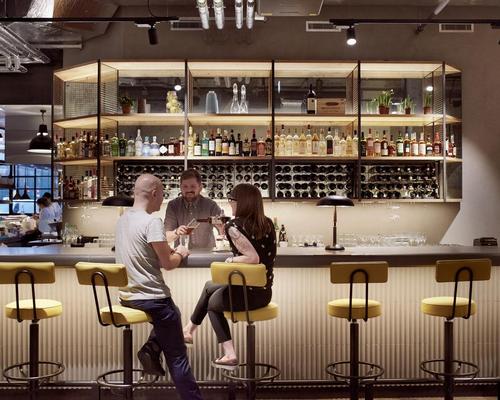14 Jul 2017
Studio RHE merge restaurant with co-working space at London's placemaking Palatino
BY Kim Megson

British architecture practice Studio RHE have merged an Italian restaurant and a modern co-working space under one roof in London’s Clerkenwell design district.
Palatino is both the entrance space for newly opened co-working venue Fora Space, and a stand alone restaurant by Stevie Parle, chef and owner of the brands Dock Kitchen, Rotorino and Craft London.
Entrance to both comes through an architectural black steel revolving door and into a welcoming hotel concierge-style reception. This leads to a striking curved cast and fluted concrete bar that defines the restaurant space. Set behind is Palatino’s open gallery kitchen, designed around three core elements: a fresh pasta machine; a wood burning grill and a stone oven for fresh pizza bianco and pastries.
Both spaces share a similar design concept, including the use of exposed steel, black painted metal, muted grey walls, pale timber furniture and a mix of warm antique glass and reclaimed lighting fixtures. Palatino’s addition of bright yellow leather upholstery, which contrasts with a long central scrubbed timber table, is intended to give the space a distinctive and vibrant accent colour. These banquettes are designed for meetings that can freely turn into lunches and dinners and vice versa.
“The biggest opportunities came from the mix of brief for each of the areas and the successful merging of them,” said Studio RHE director Richard Hywel Evans. “Mixing between the public and private co-working areas was a challenge. For example, we had to separate the acoustics despite our design aspirations for both places being the same. For this, we used electronic acoustic masking.
“It was exciting to work on a restaurant that is part of a larger concept – placed at the front of a new co-working space. In fact, the initial premise was that the barista could double as the receptionist.”
Evans added that the decision to merge a restaurant with co-working space – where food, drink and socialising can play an important part of the overall experience – demonstrates the type of non-traditional thinking restaurateurs and designers should consider to maximise their chances of business success.
“Placemaking is key to the success of a restaurant; how it feels to be there at different times of the day and how it presents itself to the world,” he said. “Design can play a major part in the success of a new restaurant concept, creating an immediate legible place and atmosphere that is ready from the launch.
“Restaurants no longer have the luxury of emerging over years of practice and change, they are evaluated as soon as the doors open and there is often no recovery from a bad start.”
Close Window